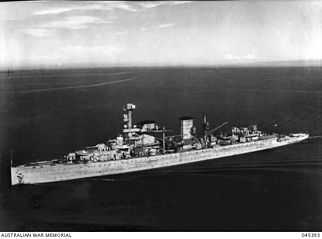Java-class cruiser
 Java circa 1940-42 | |
| Class overview | |
|---|---|
| Name: | Java class |
| Builders: |
Koninklijke Maatschappij de Schelde, Flushing Nederlandse Scheepsbouw Maatschappij, Amsterdam Wilton Feijenoord, Schiedam (cancelled) |
| Operators: |
|
| Preceded by: | Holland class |
| Succeeded by: | De Ruyter |
| Planned: | 3 |
| Completed: | 2 |
| Lost: | 2 |
| General characteristics | |
| Type: | Light cruiser |
| Displacement: | 6670 tons standard 8087 tons full load |
| Length: | 155.3 m (509 ft 6 in) |
| Beam: | 16 m (52 ft 6 in) |
| Draught: | 6.22 m (20 ft 5 in) |
| Propulsion: | 3 Parsons geared steam turbines 8 Schultz-Thornycroft boilers 3 shafts 73,000 shp (54,000 kW) |
| Speed: | 31 knots |
| Range: | 4,340 nmi (8,040 km; 4,990 mi) at 11 or 12 kn (22 km/h; 14 mph) |
| Complement: | 526 |
| Armament: | 10 x Bofors 150 mm guns 8 (Java) or 6 (Sumatra) x Bofors 40 mm anti-aircraft guns 8 x Browning .50 machine guns |
| Armour: | 7.5 cm (3.0 in) belt 2,5 to 5 cm (2.0 in) deck 12.5 cm (4.9 in) conning tower 10 cm (3.9 in) shields |
| Aircraft carried: | 2 Fokker C.XI-W floatplanes |
The Java class was a class of light cruisers of the Royal Netherlands Navy, named after the island of Java in the Dutch East Indies (now Indonesia). Originally, three ships were planned: Java, Sumatra, and Celebes. Celebes was intended to be the flagship of the naval commander in the Dutch East Indies, and therefore she was slightly bigger than the other two ships. However, the contract was cancelled with 30 tons of material already prepared (A new ship, HNLMS De Ruyter was later built to fill that place).
The class was designed by the Germaniawerft in Kiel, but constructed in the Netherlands. They were designed to counter the Japanese reconnaissance cruisers of the Chikuma class of 1912, and by 1913 standards they were big, fast and heavily armed with 10 x 150 mm (5.9 inch) guns. However, these were not turret-mounted, and by the time the cruisers were finally launched after all the delays caused by the upheaval of World War I (Sumatra in 1920, Java in 1921), they had already become outdated.
Nevertheless, both Sumatra and Java were still active at the outbreak of World War II, mainly for colonial duties.
Ships
| Name | Laid down | Launched | Commissioned | Decommissioned |
|---|---|---|---|---|
| Java | 31 May 1916 | 6 August 1921 | 1 May 1925 | sunk 27 February 1942 |
| Sumatra | 15 July 1916 | 29 December 1920 | 26 May 1926 | sunk 29 April 1944 |
| Celebes | Cancelled 1919 | |||
Service history
Java

Designed in 1913, built in the Schelde naval shipyards and launched on 9 August 1921, Java was already old-fashioned by the time she was commissioned in 1925.
Java saw action, mostly as a convoy escort, during the Spanish Civil War and during the early stages of World War II. At the outbreak of war with Japan Java was in Indonesian waters where she formed part of the fleet of ABDA command under the command of rear-admiral Karel Doorman. She fought in the battle of Badung Strait in February 1942. During the Battle of the Java Sea on 27 February 1942, she was sunk at 23:00 together with De Ruyter by, reportedly, a Long Lance torpedo from the Japanese cruiser Nachi and went down with the loss of 500 crewmembers.
Sumatra
Sumatra also performed convoy duties during World War II and transported part of the Dutch Royal Family to safety in Canada, but due to problems with her propulsion she was unfit for combat duty.
In the end Sumatra was scuttled off the coast of Normandy on 9 June 1944 at Ouistreham as part of a "gooseberry" pier to protect an artificial Mulberry Harbour built by the Allies as part of Operation Overlord. Sumatra 's 150 mm guns were used to replace the guns of the Flores-class gunboat, which were worn out by extensive use.
References
External links
| Wikimedia Commons has media related to Java class cruiser. |
| ||||||||||||||||||
| ||||||||||||||||||||||||||
| ||||||||||||||||||||||||||||||||||||||||||